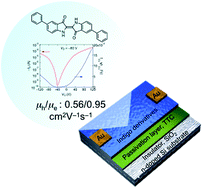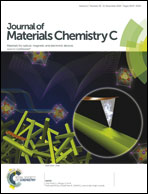High performance ambipolar organic field-effect transistors based on indigo derivatives†
Abstract
A bio-inspired organic semiconductor 5,5′-diphenylindigo shows excellent and well-balanced ambipolar transistor properties; its hole and electron mobilities are 0.56 and 0.95 cm2 V−1 s−1, respectively. The enhanced performance is attributed to the extended π–π overlap of the phenyl groups as well as the characteristic packing pattern that is a hybrid of the herringbone and brickwork structures. The ambipolar transistor characteristics are analyzed considering its operating regions, where a large unipolar saturated region appears due to the difference of the electron and hole threshold voltages.


 Please wait while we load your content...
Please wait while we load your content...